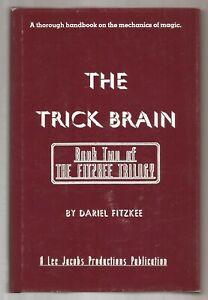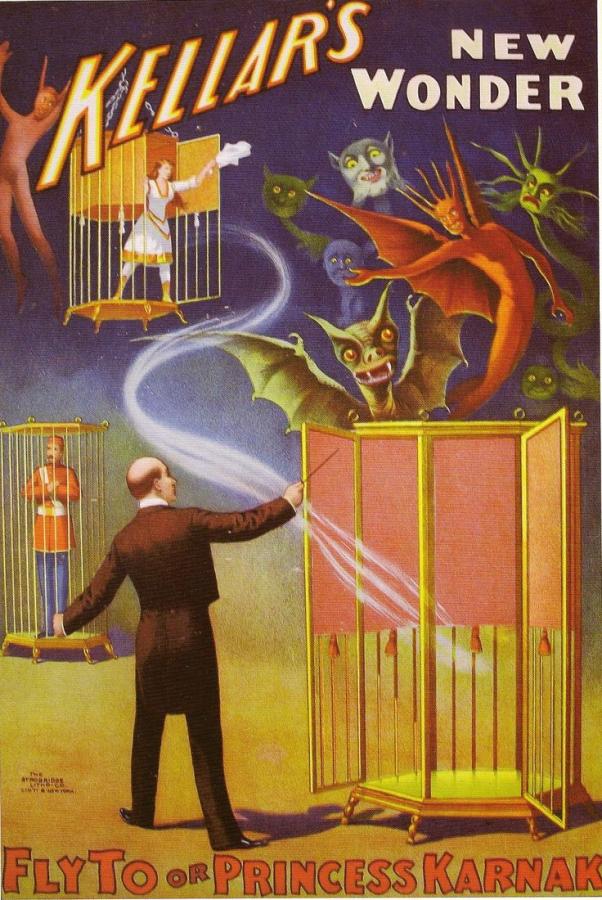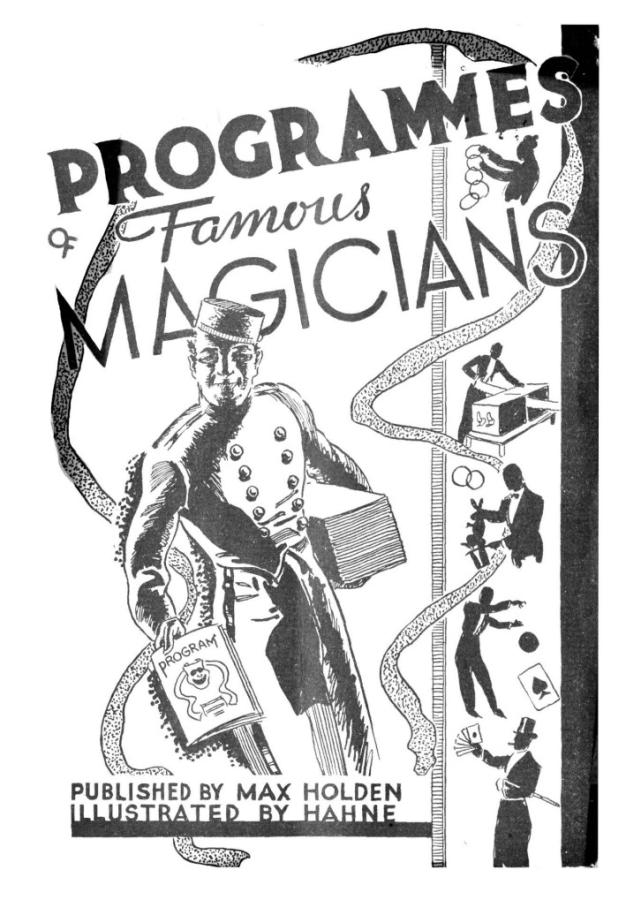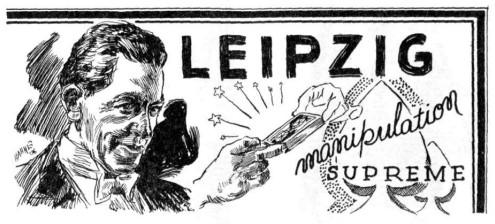Putting Together a Unique Magical Programme
We’ve got tens of thousands of magic books published over the past century, each containing dozens of original routines… so why do all magicians seem to do the same six tricks?
We magicians aren't as original as we like to think. Much of our inventive work is in the details, but the audience doesn't care if the card gets loaded into the wallet from the top or from the side. Thankfully, the majority of audience members are seeing a magician for the first time when they watch you. Still, I wonder what they think when they realize the next magician also has those big steel rings... and puts ketchup bottles into paper bags... and receives bananas in the mail...
I feel as guilty of this as anyone, and never does my pool of magical repertoire seem so shallow as when I’m trying to coordinate with other magicians on the same show.
“Oh, you’re doing a rope trick? Okay, I won’t do ropes. You’re doing a thing with envelopes, okay, scratch my Bank Night then.”
It’s not just a one-for-one trade either. One routine can knock out a wide swath of other possibilities. If I’m doing the Benson Bowl routine, in which sponge balls are appearing under a bowl, then it removes the Cups & Balls, Chop Cup, and any other sponge ball routine from consideration.
If I do my Professor’s Nightmare routine, it doesn’t matter what you do with a piece of rope. It looks and feels too similar from the audience perspective.
Magicians get upset when they ask someone to “pick a card” and they say “oh, I’ve seen this one,” as if there’s only one pick-a-card trick in the world. But in show business the audience perception is audience reality. I’d argue that a general magic show should only have one pick-a-card trick, and if you do it again you need to make it feel very different.
As with any performance, it’s about creating the best experience for the audience and the best experience doesn’t include a feeling of “oh, we’ve seen this before.”
Your goal is to create a full programme of new, exciting, interesting, magical surprises and delights.
Not so easy!
Side note: It’s a major disappointment when I attend a magic club or convention show with repetitive tricks. This should be the responsibility of the show producer when arranging the programme, but failing that the acts themselves need to have a discussion. Being subjected to multiple Linking Ring routines in the same show is protected by the Universal Declaration of Human Rights. (somewhere near the end, I’m pretty sure.)
Checking All The Boxes
Assembling a diverse program is a challenge, even for a solo act, when you’re looking to fill an evening with an hour or more worth of magic.
One classic bit of wisdom is to consult a list with all the basic types of magic effects. Depending who you ask, and which book they’re reading, this list might have eight, ten, or more classifications. Here’s the list from Dariel Fitzkee’s “The Trick Brain” (1944)

- Production (Appearance, creation, multiplication)
- Vanish (Disappearance, obliteration)
- Transposition (Change in location)
- Transformation (Change in appearance. character or identity)
- Penetration (One solid through another)
- Restoration (Making the destroyed whole)
- Animation (Movement imparted to the inanimate)
- Anti-Gravity (Levitation and change in weight)
- Attraction (Mysterious adhesion)
- Sympathetic Reaction (Sympathetic response)
- Invulnerability (Injury proof)
- Physical Anomaly (Contradictions, abnormalities, freaks)
- Spectator Failure (Magicians' challenge)
- Control (Mind over the inanimate)
- Identification (Specific discovery)
- Thought Reading (Mental perception, mind reading)
- Thought Transmission (Thought projection and transference)
- Prediction (Foretelling the future)
- Extra-Sensory Perception (Unusual perception, other than mind)
The concept being to make sure your set list represents a variety of these effect types, and you’re not repeating your favourites too much.
This is even more delicate for a mentalist, as they are limited to only a few effects. I’ve seen performances struggling to create a full meal with only one ingredient. “Pick any one of these six cards and it matches my prediction. Now pick any one of these five teddy bears and it matches my prediction. Now pick…”
This list alone, however, does not ensure variety. You could spend an hour doing every single one of those effects using only coins, but your audience would be grinding their teeth by the end of it, totally numb to seeing yet another coin trick.
Memorable Moments
Ultimately it comes down to creating unique theatrical moments, which means the danger of repetitive action goes beyond the level of different tricks or effects in your repertoire. The granular elements must also be unique. If I throw a frisbee into the audience to have some random numbers said aloud, it becomes less exciting to later throw a beach ball around the crowd to have a card named. Even if the tricks are entirely different, we’ve seen that idea already.
The most common cause of magic show monotony is not the props, or the tricks, but the performer themselves. They stand in the center of the stage, holding something in their hand, and talking. Over and over again. There are no theatrical dynamics. No change in their voice, physicality, or emotions.
You can put your act to the photogenic test; If a photo of your performance gets snapped every 30 seconds, how many of them would be distinct images?
It really is a lot of work to make every moment of your show unique, fresh, and different. But as a small step all you need to do is make a new choice in that moment. Change where you stand. Change how you speak. Change the picture. Do anything… different.
Peek At The Pro's Set List
I’m always curious about other magicians’ set lists to see how they assemble a unique show. What are you actually performing? In what order? Admittedly this curiosity is largely driven by this feeling that I’m always making it up as I go along, and I assume everybody else has it figured out.
I also assume I’m not alone in this feeling, as there’s always an uptick in interest for an old trick after it gets performed on TV. This desire for the safety of somebody else’s proven winners is a big factor in the ‘sameness’ of our collective repertoire.
Fortunately, I can satisfy my curiosity into working repertoires, without jumping onto the same wagon as every other magician, thanks to the publication of a couple fascinating old books. These collections simply describe the acts of magicians, from the audience perspective. What they did, and the order in which they did it.
Even more fortunately, these books are so old that they are in the public domain, and I can share them with you in their entirety.
Programmes of Magicians
Published in 1906, written by J.F. Burrows, “showing at a glance the tricks performed by all the leading conjurors, extending over a period of forty-two years, from 1864 to 1906. - An Invaluable Guide for the Amateur and Professional. Just the Book that every Magician wants.”
From those yellowed pages, a short description of a performance by Professor Fuller shows we haven’t changed much in the past 150 years.
The passe-passe bottle, cardboard cylinders and glass (bottle and glass change places). A watch passed from a stocking into the nest of boxes, The inexhaustible hat (balls, cannon ball, metal lanterns, etc.). The metal cone and production of a plant in a pot. The sword passed through the body. The inverted glass of water (defies the laws of gravity).
It’s got a good variety of effects and moments. That would still make for a nice 15 to 20 minute act today.
We can also sit in on a full evening show presented by Harry Kellar;

Five handkerchiefs are produced, and vanished by various methods, and reproduced from the collar of a spectator. Catching money in the air, and production of baby's clothes from hat. Changing paper shavings into coffee, milk and sugar. Production of flowers from a paper cone. Borrowed rings fired from a pistol into a nest of boxes, one missing, found later tied round the neck of a guinea pig taken from a bottle, from which various drinks were previously poured. Real flowers on two trees produced from an empty cone. A lady tied to a chair suspended from a scaffold, she vanishes, and the empty chair drops to floor. Wine and water poured from the same jug. Lady hypnotised on a board rises and remains suspended in the air. Two persons produced from an empty cabinet. Lady in a basket of flowers produced on a table, apparently from space. Small empty cabinet placed on the top of a sheet of glass, a tambourine, bell, etc., placed inside, when the usual spiritualistic manifestations take place. Second sight exhibition (chess knight's tour, reading all the cards in a shuffled pack, banknote test, addition sum and mental arithmetic on blackboard). Another cabinet illusion with spiritualistic effects. Vanish and reproduction of a young lady.
This is a great example of variety with a constant string of surprises. The old coffee trick is ripe for a resurgence in our current culture. It’s also interesting to see the great illusionist presenting a complete mentalist act, a la Dunninger, as a third act change of pace.
I lament that the desire for practicality in our magic props has given us a modern magic show which fits in a suitcase, but compromises on presenting a spectacular evening of entertainment.
No doubt inspired by the previous book, Max Holden set out to document the acts of modern magicians, at the time of publication in 1937.

Since we’re on the topic of variety it might be interesting to highlight the programme of Nate Leipzig as he famously performed with only a deck of cards.

Two or more spectators are requested to come upon the stage to act as a committee.
Leipzig Four Ace Trick — Ace of hearts is placed on the bottom of the pack and the Ace of Clubs on top. The Ace of Diamonds and the Ace of Spades are placed in the center. The pack is riffled and Leipzig runs through the pack to show that the Aces have vanished. Still, on slapping the pack with the right hand, each Ace makes its appearance on the face of the pack.
Three Cards are Peeked at by different spectators and the pack is dealt on the table one at a time after being shuffled by Leipzig. The spectator who peeked at the first card is asked to stop him anytime as Nate remarks "The card that you peeked at will be the exact card at which you stop me." The correct card is found. The second peeked at card is now found by the spectator when he deals the cards himself and stops at a free choice. The third card was found by spectator by inserting a knife into the pack. This card was not the selected card but when the spectator named his card, it was found to have changed to the correct card.
Stabbing Trick — Two cards are selected and returned to the pack which is then shuffled and wrapped in a piece of newspaper. A knife is thrust into the packet and the paper torn away. On each side of the knife are found the two selected cards.
Twenty Card Trick — A spectator is requested to count ten cards on Leipzig's outstretched right hand. Another ten cards are counted on the left hand. The cards in the left hand are wrapped in a handkerchief and handed to one spectator. The other ten cards are once more counted by Leipzig. One card is commanded to pass over to the packet held by the spectator. The cards are counted and only nine cards remain. Again a card passes over leaving eight cards in Leipzig's hands. Still another card passes over leaving only seven cards and when the spectator opens his packet he finds that he is holding thirteen cards.
I was intrigued at the inclusion of the stabbing trick when the previous routine also includes finding a card by stabbing a knife into the deck. Although, the first time the stabbed card is wrong. I plucked “The Leipzig Book” by Dai Vernon and Lewis Ganson (1963) off the shelf, and it offers a more detailed description of the act.
It turns out the first stab, the one that misses, has the spectator holding the knife trying to find their own card. This makes for a great lead-in to Leipzig’s own stabbing effect under challenge conditions.
The book also reveals, at least in earlier years, Leipzig was opening this act with a thimble routine. So I don’t want to hear objections from the “I only do cards” people… get yourself some thimbles like a real pro!
The urge is strong to pick up a trick after seeing another person have success with it. These two ‘Programmes Of…’ books offer one of the few options for ethically stealing from another performer’s act. Rather than copying ‘being inspired by’ your peers, these programmes are all off the market and ready to be stripped for parts like a rusted car.
Side Note: I was directed to two more books carrying on this tradition through the decades; “Spotlight On 101 Great Magic Acts” by Tony Taylor (1964) and Ian Keable collected up modern magicians in his 2010 book “Magic Shows: 30 Years of Programmes from Daniels to Derren”
Your Unique Path Through Magic
My cynical side is thinking most magic show programmes are more strongly influenced by the latest dealer catalogue than by careful consideration of a well-rounded audience experience.
On the other hand the checklist approach to variety seems arbitrary, making the repertoire selection seem overly important as if you can classify your way to a winning show. The trick doesn’t matter. There’s no formula for success. Paint-by-numbers does not an artist make. How you do it is more important than what you do.
Have the courage to pick up a long lost trick and put yourself into it. You don’t need Dai Vernon’s blessing to tell you it’s a good trick. Your audience will do that better than any other magician can. The thing that will make any trick uniquely special is the thoughtful effort you pour into that vessel.
What would you perform if you were on a show with six other mystery magicians, and you all had to go in blind with no discussion? What could you do to feel confident in your uniqueness?
As with everything in putting your show together, it’s more important that you consider the question, than find the ultimate answer. If you can think about how this next card trick is going to feel uniquely different than the previous twelve, you’re all set. You can leave the thimbles in the cookie tin.
Programs of Famous Magicians
Eugene Burger listed this as one of his FAVORITE books!
Counterpoint
"If I’m doing the Benson Bowl routine, in which sponge balls are appearing under a bowl, then it removes the Cups & Balls, Chop Cup, and any other sponge ball routine from consideration." https://www.youtube.com/watch?v=B9Kd6dSxv3I
Don Alan in action
This video has Don Alan on a TV show performing the Chop Cup, Benson Bowl, and a coin trick with a hat which ends with one more final load. Certainly a lot of repetetive action and themes!
I suspect his is a choice made for TV, as these are all short punchy tricks. The saving grace is that Don works very fast, which almost makes all the routines blend into one, with the progressively larger final loads becoming the primary effect.
I still don't recommend it!
You must sign in to add a comment.